change time OLDSMOBILE SILHOUETTE 1997 Owners Manual
[x] Cancel search | Manufacturer: OLDSMOBILE, Model Year: 1997, Model line: SILHOUETTE, Model: OLDSMOBILE SILHOUETTE 1997Pages: 436, PDF Size: 21.87 MB
Page 4 of 436
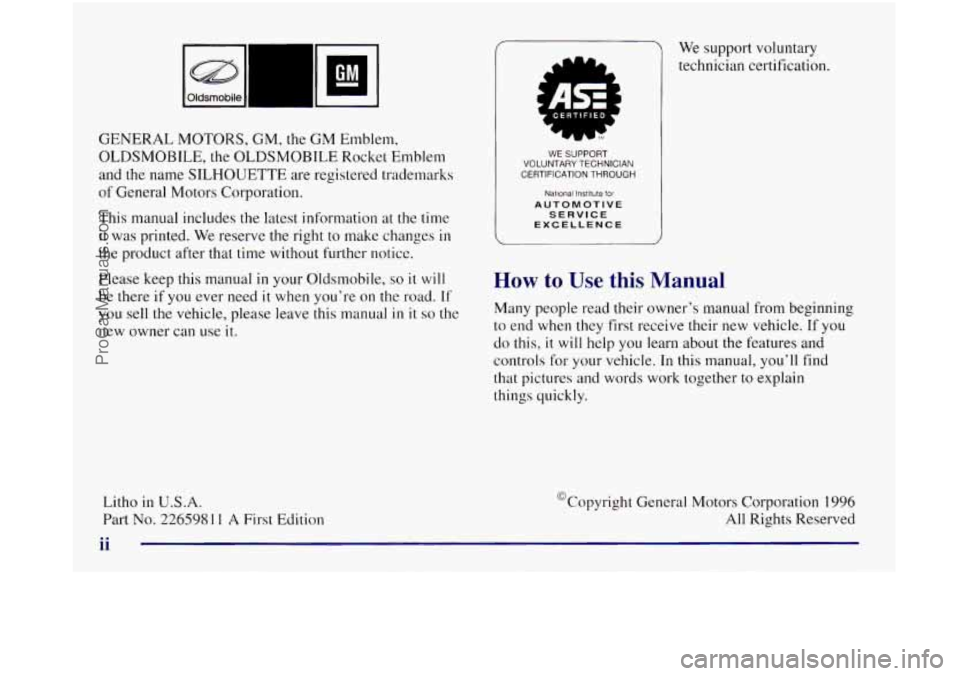
GENERAL MOTORS, GM, the GM Emblem,
OLDSMOBTLE, the OLDSMOBILE Rocket Emblem
and the name
SILHOUETTE are registered trademarks
of General Motors Corporation.
This manual includes the latest information
at the time
it was printed. We reserve the right to make changes in
the product after that time without further notice.
Please keep this manual
in your Oldsmobile, so it will
be there if you ever need it when you’re on the road. If
you sell the vehicle, please leave this manual in it so the
new owner
can use it.
Litho in U.S.A.
Part No. 2265981 1 A First Edition
WE SUPPORT VOLUNTARY TECHNICIAN
CERTIFICATION THROUGH
Natlonal Institute for
AUTOMOTIVE SERVICE
EXCELLENCE
We support voluntary
technician certification.
How to Use this Manual
Many people read their owner’s manual from beginning
to end when they first receive their new vehicle. If you
do this,
it will help you learn about the features and
controls for your vehicle. In this manual, you’ll find
that pictures and words work together
to explain
things quickly.
0 Copyright General Motors Corporation I996
All Rights Reserved
ii
ProCarManuals.com
Page 89 of 436
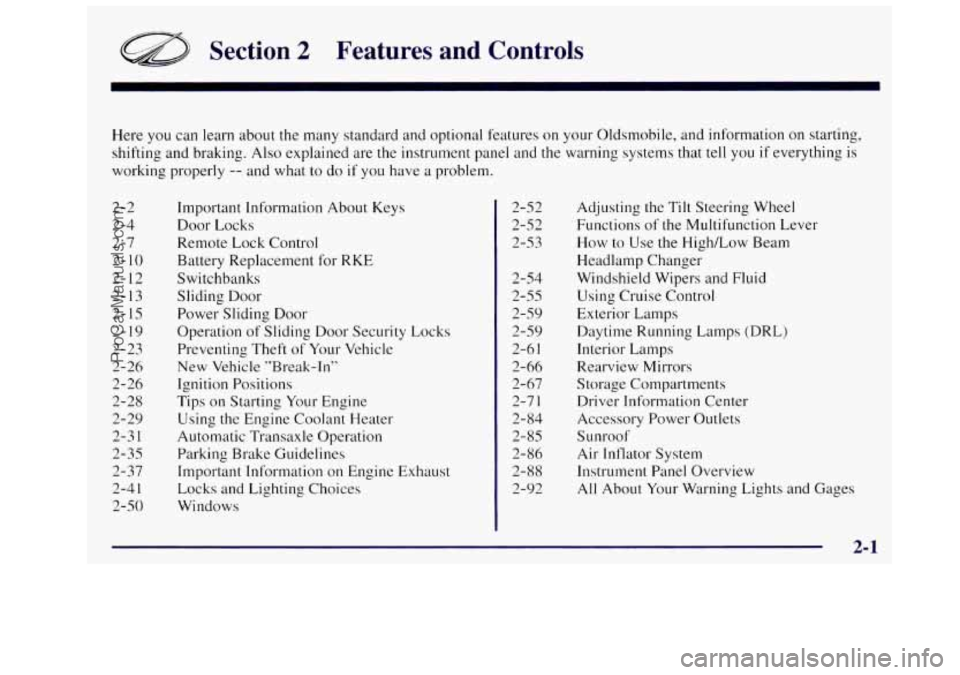
Section 2 Features and Controls
Here you can learn about the many standard and optional features on your Oldsmobile, and information on starting,
shifting and braking. Also explained are the instrument panel and the warning systems that
tell you if everything is
working properly
-- and what to do if you have a problem.
2-2 2-4
2-7
2-
10
2- 12
2-13 2-15
2-19
2-23
2-26 2-26
2-28 2-29
2-3 1
2-35
2-37
2-4
1
2-50 Important Information About Keys
Door Locks
Remote Lock
Control
Battery Replacement for RKE
Switchbanks
Sliding Door
Power Sliding Door
Operation of Sliding Door Security Locks
Preventing Theft
of Your Vehicle
New Vehicle "Break-In"
Ignition Positions
Tips on Starting
Your Engine
Using the Engine Coolant Heater
Automatic Transaxle Operation
Parking Brake Guidelines
Important Information on Engine Exhaust
Locks and Lighting Choices
Windows 2-52
2-52
2-53
2-54
2-55
2-59
2-59
2-6
I
2-66
2- 67
2-7
I
2- 84
2-85
2- 86
2-88
2-92 Adjusting the
Tilt Steering
Wheel
Functions of the Multifunction Lever
How to Use
the High/Low Beam
Headlamp Changer
Windshield Wipers and Fluid
Using Cruise Control
Exterior Lamps
Daytime Running Lamps (DRL)
Interior Lamps
Rearview Mirrors
Storage Compartments
Driver Information Center
Accessory Power Outlets
S u nroo f
Air Inflator System
Instrument Panel Overview
All About Your Warning Lights and Gages
ProCarManuals.com
Page 96 of 436

This device complies with RSS-210 of Industry
and Science Canada. Operation is subject to the
following two conditions:
(1) this device may not
cause interference, and (2) this device must accept
any interference received, including interference that
may cause undesired operation of the device.
The range of this system is about 30 feet
(9 m). At times
you may notice a decrease
in range. This is normal for
any remote lock control system.
If the transmitter does
not work or if you have
to stand closer to your vehicle
for
the transmitter to work, try this:
0
0
0
0
Check to determine if battery replacement or
synchronization
is necessary. See the instructions
that follow.
Check the distance.
You may be too far from your
vehicle.
You may need to stand closer during rainy
or snowy weather.
Check
the location. Other vehicles or objects may
be blocking the signal. Take a few steps to the
left
or right.
If you’re still having trouble, see your Oldsmobile
retailer or a qualified technician for service.
Changes or modifications to this system by other than an
authorized service facility could void authorization to
use this equipment.
Operation
Remote Driver’s Door and All Door Unlock
When you press UNLOCK on the key chain transmitter,
only
the driver’s door will unlock. If you press
UNLOCK again within five seconds, all the doors and
the liftgate will unlock.
If you would like all the doors to
unlock the first time you press UNLOCK, see “Locks
and Lighting Choices” in the Index.
If your vehicle is equipped with the Content Theft
Deterrent system, The UNLOCK button on the key
chain transmitter will disarm the system (see “Content
Theft Deterrent”
in the Index for more details).
Remote All Door Lock
To lock all doors, press LOCK on the key chain
transmitter (see “Power Door Locks”
in the Index for
more details on the power door lock features).
If your
vehicle is equipped with the Content Theft Deterrent
system, the LOCK button may arm the system (see
“Content Theft Deterrent”
in the Index for more details).
2-8
ProCarManuals.com
Page 98 of 436

Matching Transmitter(s) To Your Vehicle
Each key chain transmitter is coded to prevent another
transmitter from unlocking your vehicle.
If a transmitter
is lost or stolen,
a replacement can be purchased through
your retailer. Remember to bring any remaining
transmitters with you when you
go to your retailer.
When
the retailer matches the replacement transmitter
to your vehicle, any remaining transmitters must also
be matched. Once your retailer has coded the
new
transmitter, the lost transmitter will not unlock your
vehicle. Each vehicle can have only four transmitters
matched to
it.
See your retailer to match transmitters to another vehicle.
Battery Replacement
Under normal use, the battery in your key chain
transmitter should last about two years.
You can tell the battery is weak if the transmitter won’t
work at the normal range
in any location. If you have to
get close to your vehicle before
the transmitter works,
it’s probably time to change the battery.
I NOTICE:
When replacing the battery, use care not to
touch any
of the circuitry. Static from your
body transferred to these surfaces may damage
the transmitter.
2-10
ProCarManuals.com
Page 143 of 436

Rear Window Wiper and Washer
\-
I The rear window wiper
switch
is located in
the Instrument Panel
switchbank.
Push the wiper symbol on the bottom
of the button to
turn on the intermittent wiper. To turn off the wiper,
gently push the top
of the button.
To wash and wipe the rear window, push in the washer
symbol on the top
of the button. Washer fluid will spray
as long as the button is held
in. When the top of the
button is released, the wiper will continue to cycle three
more times.
To wash the rear window when the rear wiper is already on,
push on the top
of the button with the wash symbol on it.
Push in the bottom of the button to continue the intermittent
wiper cycle after the washing cycle is completed.
Cruise Control (Option)
With cruise control, you can maintain a speed of about
25 mph (40 km/h) or more without keeping your foot
on the accelerator. This can really help
on long trips.
Cruise control does not work at speeds below about
25 mph (40 kmh).
When you apply your brakes,
the cruise control
shuts
off.
0 Cruise control can be dangerous where you
can’t drive safely at
a steady speed. So,
don’t use your cruise control on winding
roads or in heavy traffic.
slippery roads. On such roads, fast changes
in tire traction can cause needless wheel
spinning, and you could lose control. Don’t
use cruise control on slippery roads.
0 Cruise control can be dangerous on
2-55
ProCarManuals.com
Page 159 of 436

Sunglasses Storage Compartment Driver Information Center
To
open the sunglasses storage compartment in the
overhead console, press the release button. Then pull the
compartment down to the full open position. The DIC will show information about the vehicle and
the surroundings.
0 English/Metric
Button (E/M) - You can change the
display
to a metric or English reading at any time by
pressing
E/M.
ProCarManuals.com
Page 197 of 436
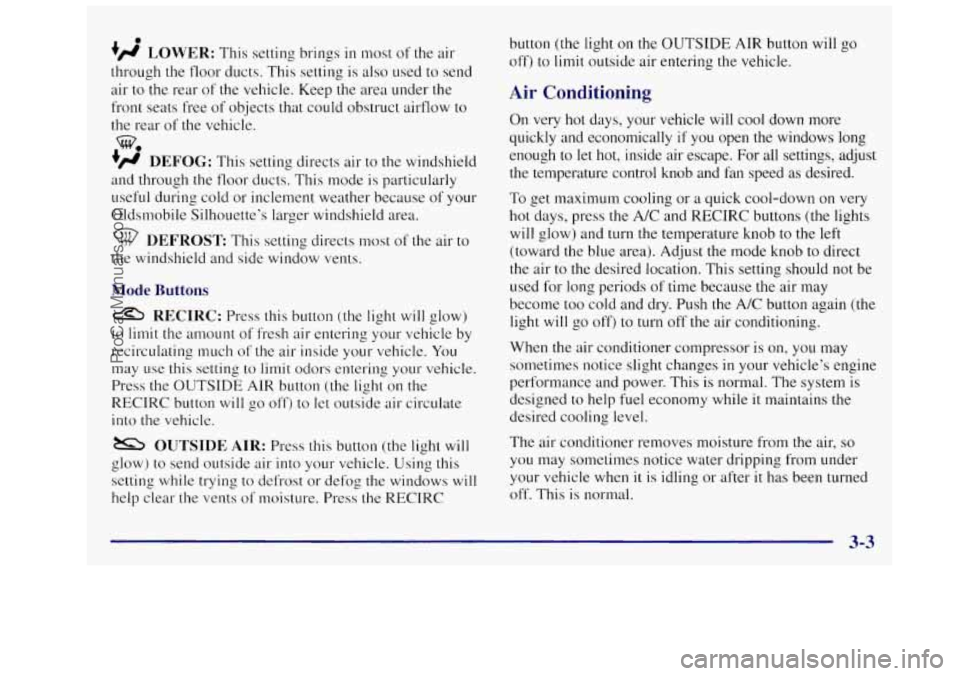
0
+fl LOWER: This setting brings in most of the air
through the floor ducts. This setting is also used to send
air to
the rear of the vehicle. Keep the area under the
front seats free of objects that could obstruct airflow to
the rear of the vehicle.
+’ DEFOG: This setting directs air to the windshield
and through the floor ducts. This mode is particularly
useful during cold or inclement weather because of your
Oldsmobile Silhouette’s larger windshield area.
w.
DEFROST This setting directs most of the air to
the windshield and side window vents.
Mode Buttons
RECIRC: Press this button (the light will glow)
to limit the amount of fresh air entering your vehicle by
recirculating much of the air inside your vehicle. You
may
use this setting to limit odors entering your vehicle.
Press the OUTSIDE AIR button (the light on the
RECIRC button
will go off) to let outside air circulate
into
the vehicle.
OUTSIDE AIR: Press this button (the light will
glow) to send outside air into your vehicle. Using this
setting while trying to defrost or defog the windows will
help clear the vents
of moisture. Press the RECIRC button
(the light
on the OUTSIDE AIR button
off) to limit outside air entering the vehicle.
Air Conditioning
will go
On very hot days, your vehicle will cool down more
quickly and economically
if you open the windows long
enough to let hot, inside air escape.
For all settings, adjust
the temperature control knob and fan speed
as desired.
To get maximum cooling or a quick cool-down on very
hot days, press
the A/C and RECIRC buttons (the lights
will glow) and turn the temperature knob to the left
(toward the blue area). Adjust the mode knob
to direct
the air to the desired location. This setting should not be
used for long periods
of time because the air may
become too cold and dry. Push the A/C button again (the
light will go off) to turn off the air conditioning.
When the air conditioner compressor is on, you may
sometimes notice slight changes
in your vehicle’s engine
performance and power. This is normal. The system is
designed to help fuel economy while it maintains
the
desired cooling level.
The air conditioner removes moisture from the air,
so
you may sometimes notice water dripping from under
your vehicle when
it is idling or after it has been turned
off. This is normal.
3-3
ProCarManuals.com
Page 216 of 436
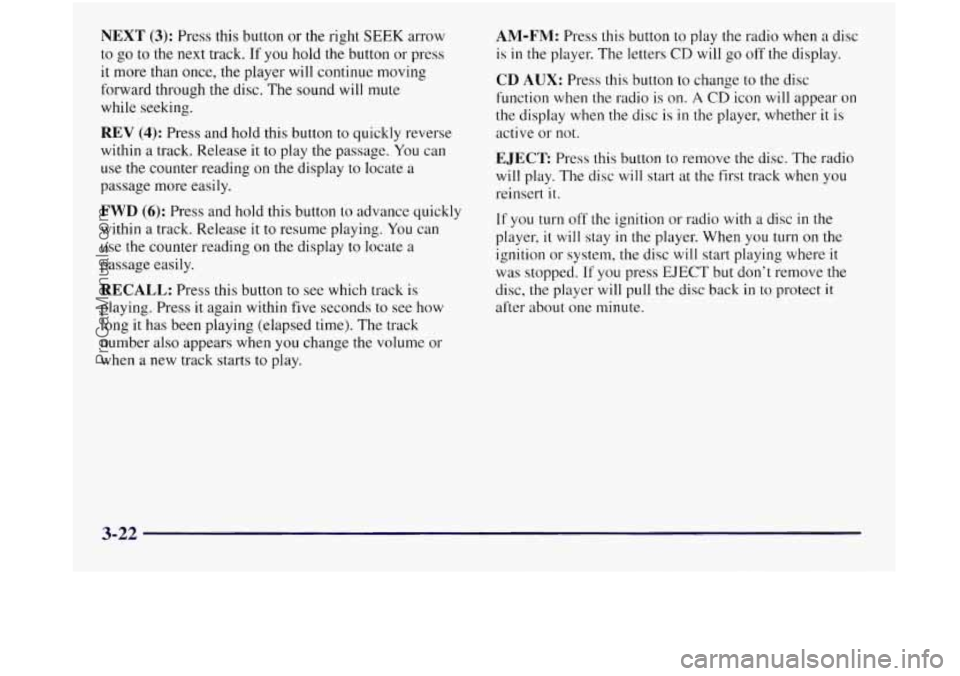
NEXT (3): Press this button or the right SEEK arrow
to go to the next track. If you hold the button or press
it more than once, the player will continue moving
forward through the disc. The sound will mute
while seeking.
REV (4): Press and hold this button to quickly reverse
within a track. Release it to play the passage. You can
use the counter reading on the display to locate a
passage more easily.
FWD (6): Press and hold this button to advance quickly
within a track. Release
it to resume playing. You can
use the counter reading on
the display to locate a
passage easily.
RECALL: Press this button to see which track is
playing. Press
it again within five seconds to see how
long
it has been playing (elapsed time). The track
number also appears when you change the volume or
when a new track starts to play.
AM-FM: Press this button to play the radio when a disc
is
in the player. The letters CD will go off the display.
CD AUX: Press this button to change to the disc
function
when the radio is on. A CD icon will appear on
the display when
the disc is in the player, whether it is
active or not.
EJECT: Press this button to remove the disc. The radio
will play. The disc will start at the first track when you
reinsert
it.
If you turn off the ignition or radio with a disc in the
player,
it will stay in the player. When you turn on the
ignition or system,
the disc will start playing where it
was stopped. If you press EJECT but don’t remove the
disc,
the player will pull the disc back in to protect it
after about one minute.
3-22
ProCarManuals.com
Page 235 of 436

Remember: Anti-lock doesn’t change the time you need
to get your foot up to the brake pedal or always decrease
stopping distance.
If you get too close to the vehicle in
front of you, you won’t have time to apply your brakes
if that vehicle suddenly slows or stops. Always leave
enough room up ahead to stop, even though you have
anti-lock brakes.
Using Anti-Lock
Don’t pump the brakes. Just hold the brake pedal
down and let anti-lock work for you. You may feel the
system working, or you may notice some noise, but this
is normal.
LOW
TRACTION
If your vehicle has the
traction control system, this
light will come on when
your anti-lock system is
adjusting brake pressure to
help avoid a braking skid.
See “Low Traction Light”
in the Index.
Traction Control System (If Equipped)
Your vehicle may have a traction control system that
limits wheel spin. This is especially useful in slippery
road conditions. The system operates only if
it senses
that one or both of the front wheels are spinning or
beginning to lose traction. When this happens,
the
system works the front brakes and reduces engine power
to
limit wheel spin.
You may feel or hear the system worlung, but this
is normal.
If your vehicle is in cruise control when the traction
control system begins to limit wheel spin, the cruise
control will automatically disengage. When road
conditions allow you to safely use
it again, you may
re-engage the cruise control. (See “Cruise Control” in
the Index.)
4-9
ProCarManuals.com
Page 240 of 436
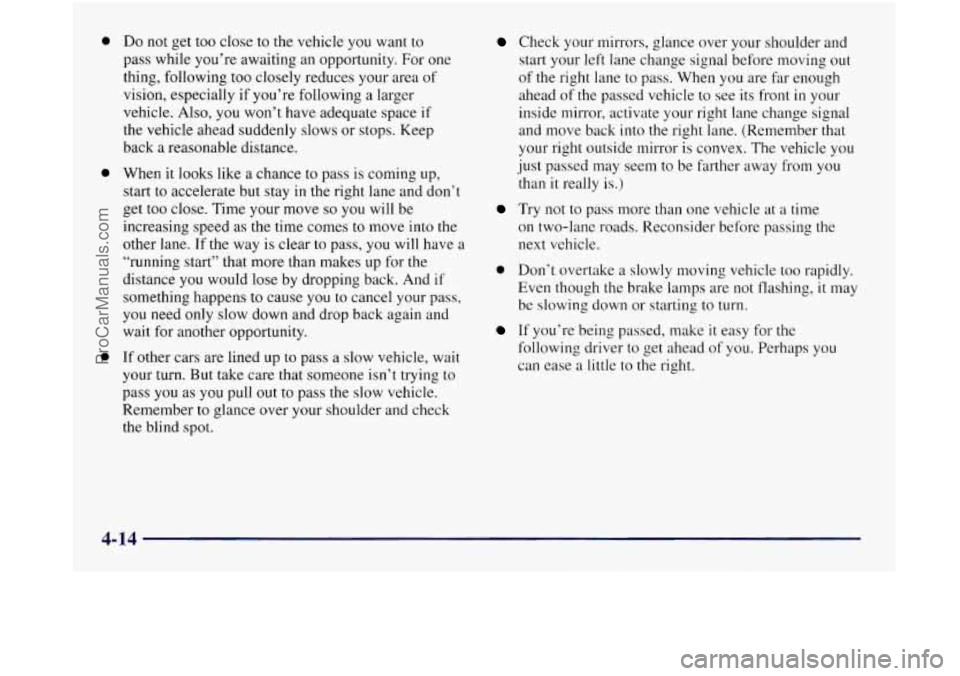
0
0
0
Do not get too close to the vehicle you want to
pass while you’re awaiting an opportunity. For one
thing, following too closely reduces your area
of
vision, especially if you’re following a larger
vehicle. Also, you won’t have adequate space
if
the vehicle ahead suddenly slows or stops. Keep
back a reasonable distance.
When it looks like a chance
to pass is coming up,
start to accelerate but stay in the right lane and don’t
get too close. Time your move
so you will be
increasing speed as the time comes to move into the
other lane. If the way is clear to pass, you will have a
“running start” that more than makes
up for the
distance you would lose by dropping back. And
if
something happens to cause you to cancel your pass,
you need only slow down and drop back again and
wait for another opportunity.
If other cars are lined up
to pass a slow vehicle, wait
your turn. But take care that someone isn’t trying to
pass
you as you pull out to pass the slow vehicle.
Remember to glance over your shoulder and check
the blind spot.
Check your mirrors, glance over your shoulder and
start your left lane change signal before moving out
of the right lane to pass. When you are far enough
ahead of the passed vehicle to see its front in your
inside mirror, activate your right lane change signal
and move back into the right lane. (Remember that
your right outside mirror
is convex. The vehicle you
just passed may seem to be farther away from you
than it really is.)
Try not to pass more than one vehicle at a time
on two-lane roads. Reconsider before passing the
next vehicle.
0 Don’t overtake a slowly moving vehicle too rapidly.
Even though the brake lamps are not flashing,
it may
be slowing down or starting to turn.
If you’re being passed, make it easy for the
following driver to get ahead of you. Perhaps you
can ease a little to the right.
4-14
ProCarManuals.com